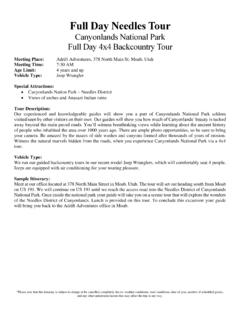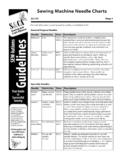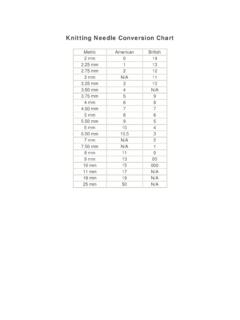Transcription of FDa, nIosH & osHa JoInt saFety coMMunIcatIon: Blunt-Tip ...
1 1 FDA, nIosH & OSHA JoInt saFety communication Blunt-Tip SUTURE needle FDa, nIosH & osHa JoInt saFety communication : Blunt-Tip Surgical Suture Needles Reduce Needlestick Injuries and the Risk of Subsequent Bloodborne Pathogen Transmission to Surgical Personnel Date IssueD May 30, 2012 auDIence Surgeons, Operating Room Supervisors, Peri operative Nurses, Hospital Administrators, Hospital Risk Managers, Occupational Health & saFety Managers, Infection Preventionists, Surgeon Educators, Surgical Residents, Medi cal School Administrators/Faculty, and other Personnel MeDIcal specIaltIes General Surgery, Urolog y, Obstetrics/Gyne colog y, Orthopedics, Anesthesiolog y, Surgical Technolog y.
2 And any specialty that includes surgery of the muscle or fascia purpose The Food and Drug Administration (FDA), the Centers for Disease Control and Preven tion s (CDC) National Institute for Occupa tional saFety and Health ( nIosH ), and the Occupational saFety and Health Administra tion (OSHA) strongly encourage health care professionals to use Blunt-Tip suture needles as an alternative to standard suture needles when suturing fascia and muscle to decrease the risk of needlestick injury. Blunt-Tip suture neeDles Blunt-Tip suture needles (Figure 1), which are not as sharp as standard (sharp-tip) suture nee dles, are designed to penetrate muscle and fas cia and reduce the risk of needlesticks.
3 Blunt-Tip suture needles are regulated by the FDA and have been marketed in the for more than 25 years. Figure 1: Blunt-Tip Suture needle 2 FDA, nIosH & OSHA JoInt saFety communication Blunt-Tip SUTURE needle suMMary oF proBleM anD scope Needlestick injuries continue to occur in surgical settings when suturing muscle and fascia, despite the availability of saFety -engineered devices, such as Blunt-Tip suture needles, and the endorsement of their use by professional organizations. Needlestick injuries have the potential to expose health care personnel to bloodborne viruses, such as Hepatitis B Virus (HBV), Hepatitis C Virus (HCV), and Human Immunodeficiency Virus (HIV).
4 Of the estimated 384,000 needle -stick injuries occurring in hospitals each year, 23 percent occur in surgical Published literature indicates that while needlestick injury rates have been decreasing among non-surgical health care providers, this has not been the case among those who work in surgical settings. Ac cording to a 2010 article published in the As sociation of periOperative Registered Nurses Journal, more than half of needlestick injuries involving suture needles occur during the sutur ing of fascia or muscle. 2 BeneFIts oF usIng Blunt-Tip suture neeDles Published studies show that using Blunt-Tip suture needles reduces the risk of needlestick injuries from suture needles by 69 Al though Blunt-Tip suture needles currently cost some 70 cents more than their standard suture needle counterparts, the benefits of reducing the risk of serious and potentially fatal blood-borne infections for health care personnel sup port their use when clinically appropriate.
5 A 2007 report suggests that the slight difference in costs of blunt- and sharp-tip suture needles is balanced by the economic savings associated with needlestick injury prevention. This re port, which assessed the costs of managing oc cupational exposures to blood and body fluids, concluded that the cost of managing a needle -stick injury can range from $376 to $2,456 per reported In addition, personnel who receive needlestick injuries may experience anx iety and a loss of productivity as they await the results of blood tests. governMent agencIes anD proFessIonal organIzatIons enDorse tHe use oF Blunt tIp suture neeDles The OSHA Bloodborne Pathogen standard, revised on , 2001 in response to the Needlestick saFety and Prevention Act of 2000, 1 Jagger J, Berguer R, Phillips EK, Parker G, Gomaa AE.
6 Increase in sharps injuries in surgical settings versus nonsurgical settings after passage of national needlestick legislation. Journal of the American College of Surgeons. 2010;210:496 502. 2 Jagger J, Bentley M, and Tereskerz P. A study of patterns and prevention of blood exposures in OR personnel. Association of periOperative Registered Nurses Journal. 1998;67(5):979-96. 4 O Malley EM, Scott RD 2nd, Gayle J, et al. Costs of management of occupational exposures to blood and body fluids. Infection Control Hospital Epidemiology. 2007; 28(7):774-82. 3 Parantainen A, Verbeek JH, Lavoie MC, Pahwa M. Blunt versus sharp suture needles for preventing percutaneous exposure incidents in surgical staff.
7 Cochrane Database of Systematic Reviews 2011;Issue 11. Art. No.: CD009170. DOI: 3 FDA, nIosH & OSHA JoInt saFety communication Blunt-Tip SUTURE needle requires the use of safer devices, such as Blunt-Tip suture needles, when clinically appropriate, to reduce the risk of needlestick injury and sub sequent pathogen transmission to personnel. The revised standard requires employers, with input from non-managerial direct patient care employees, to consider and implement available appropriate and effective safer medical devices designed to eliminate or minimize occupation al exposure.
8 In 2007, OSHA and nIosH issued a JoInt saFety and Health Information Bulletin em phasizing OSHA s requirement and nIosH s recommendation to use Blunt-Tip suture nee dles, when clinically appropriate, to decrease needlestick injuries to surgical personnel. The American College of Surgeons (ACS) recommends the universal adoption of Blunt-Tip suture needles as the first choice for the closure of fascia and muscle. This statement is endorsed by the Association of periOperative Registered Nurses, American Association of Nurse Anesthetists, American Association of Surgical Physician Assistants, American Soci ety of Anesthesiologists, American Society of PeriAnesthesia Nurses, and Association of Sur gical Technologists.
9 In addition, the 2011 Viral Hepatitis Action Plan issued by the Department of Health and Human Services recommends the use of Blunt-Tip suture needles, when clinically appro priate, to help reduce device-related needlestick exposures among health care personnel. recoMMenDatIon The FDA, nIosH , and OSHA strongly en courage health care professionals in surgical settings to use Blunt-Tip suture needles to su ture muscle and fascia, when clinically appro priate, to reduce the risk of needlestick injury and subsequent pathogen transmission to sur gical personnel. reportIng occupatIonal neeDlestIck InJurIes When an employee reports a sharps injury to their employer, the OSHA Bloodborne Patho gens standard requires the employer to record the injury, make immediately available to the employee a confidential medical evaluation and provide follow-up immediately available to the employee, and investigate and document the circumstances and type of device involved.
10 The employer can use this information to as sist in preventing similar injuries in the future. Needlestick injuries must be documented as re quired in OSHA s Recordkeeping standard (29 CFR ). In addition, OSHA s Bloodborne Pathogens standard (29 CFR (h)(5)) states that any employer required to keep occupa tional injuries and illnesses records under 29 CFR 1904 must maintain a sharps injury log to record needlestick injuries. The sharps injury log should contain, at a minimum, the follow ing information: Type and brand of device involved in the incident; 4 FDA, nIosH & OSHA JoInt saFety communication Blunt-Tip SUTURE needle Department or work area where the exposure incident occurred; and Explanation of how the incident occurred.














